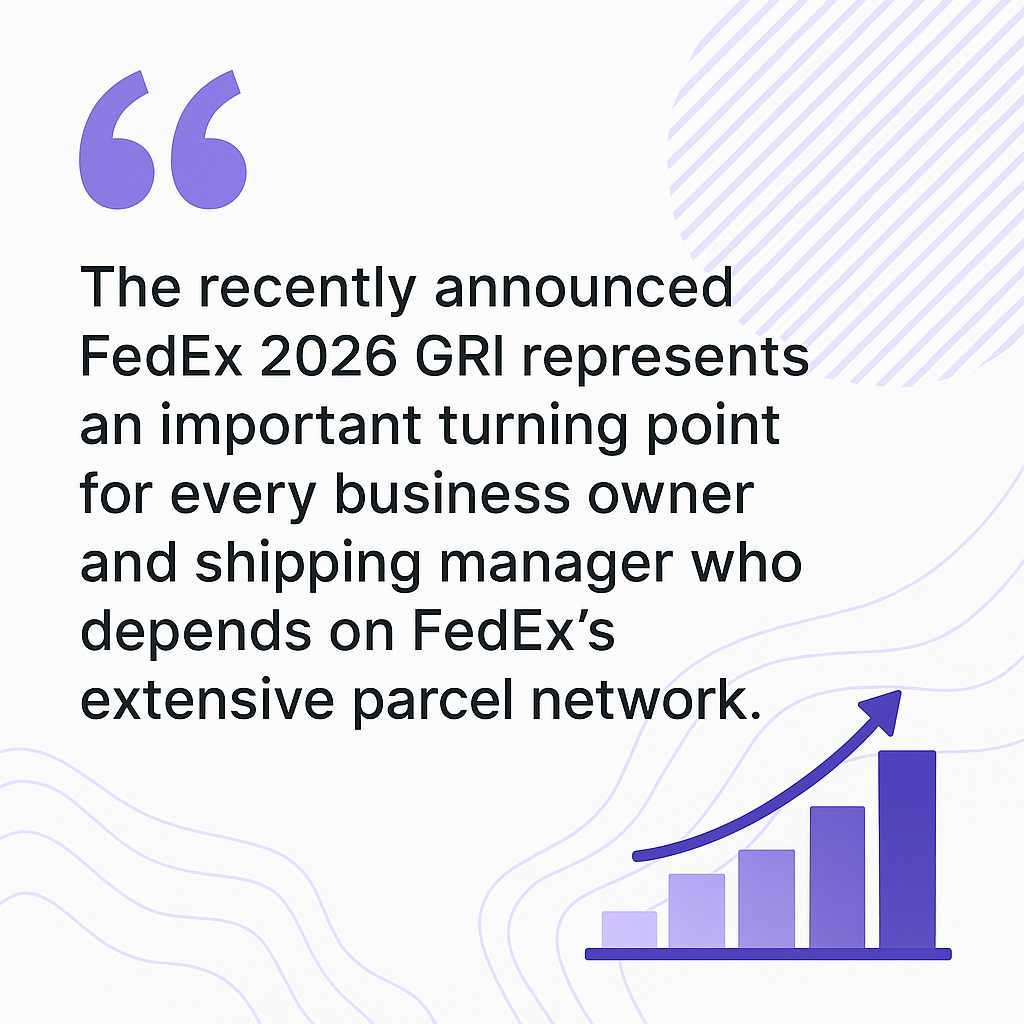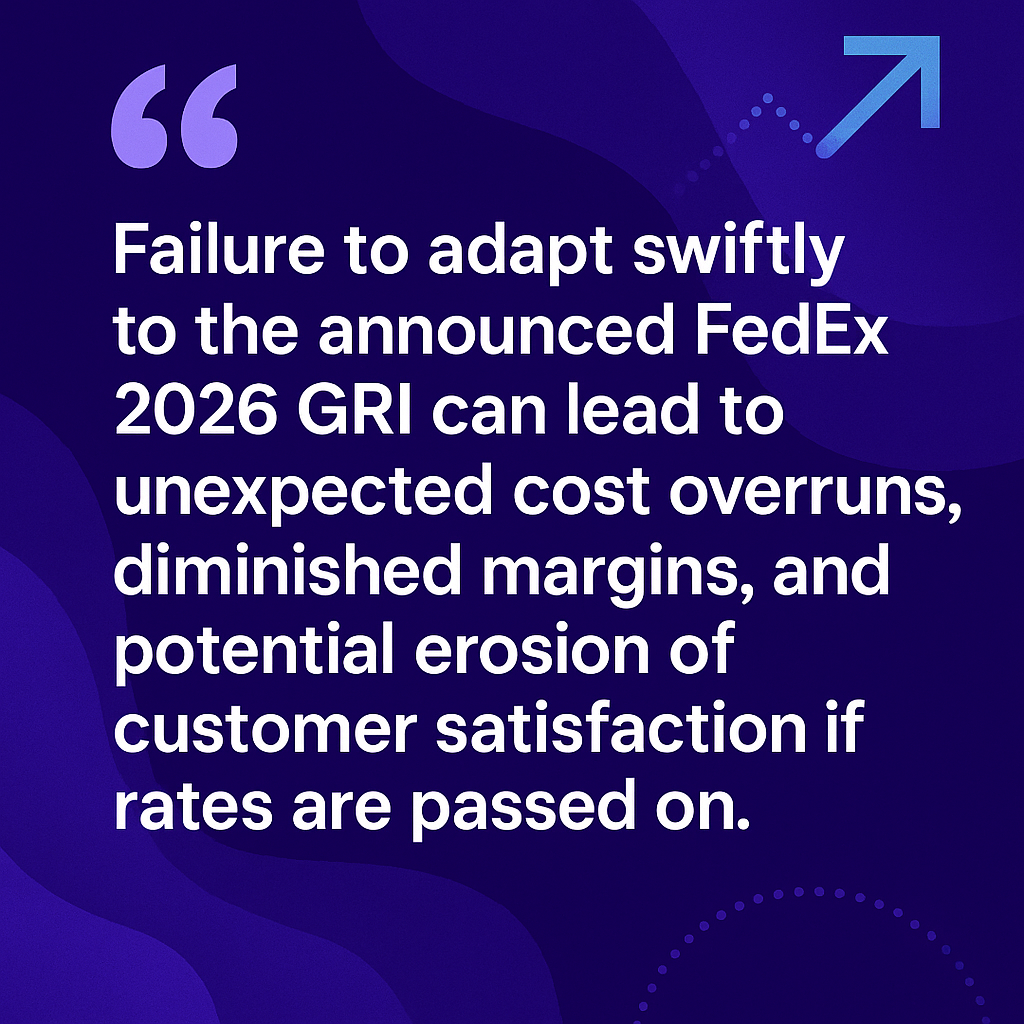FedEx 2026 GRI Announced
October 30, 2025 •Deyman Doolittle

The recently announced FedEx 2026 GRI represents an important turning point for every business owner and shipping manager who depends on FedEx’s extensive parcel network. The General Rate Increase (GRI) for 2026 was officially unveiled with key effective dates set for January 5th and January 12th, 2026, impacting a full spectrum of shipping operations across the U.S. and international markets. With a sweeping series of FedEx rate changes on the horizon, understanding their scope and acting early is crucial for controlling cost and maintaining competitive advantage.
FedEx’s annual GRI announcement is always closely tracked by industry decision-makers because it signals new pricing baselines for core services, surcharges, and operational fees. Historically, these increases set the tone for the shipping landscape, prompting companies to re-examine logistics strategies for the year ahead. For 2026, the advance notice allows organizations to scrutinize the full impact on their budgets, contract negotiations, and long-term planning. The effective dates—January 5th and 12th—point to an industry-wide shift at the very start of Q1, leaving little transition time for unprepared businesses. Early evaluations will be essential for developing mitigation plans and leveraging new avenues for shipping cost savings.
For business owners and shipping managers, failure to adapt swiftly to the announced FedEx 2026 GRI can lead to unexpected cost overruns, diminished margins, and potential erosion of customer satisfaction if rates are passed on. On the other hand, those who proactively review their spend, audit shipping profiles, and identify negotiation opportunities are positioned to retain operational efficiency and profitability, even as baseline costs rise. These annual GRIs also serve as strategic opportunities: the right intelligence enables you to benchmark against competitors and ensure you are not paying more than necessary for essential carrier services.
What is the FedEx 2026 GRI, and when does it take effect?
The FedEx 2026 General Rate Increase (GRI) is FedEx’s scheduled annual adjustment of its service rates, fees, and surcharges, encompassing most domestic and international shipping solutions, as well as value-added services. This round of increases will officially take effect on January 5 and January 12, 2026, depending on the specific service. The announced dates represent critical deadlines for shippers to audit their contracts and forecasting models, ensuring there are no surprises when higher invoices arrive.
Given FedEx’s role as a bellwether for industry rates, this adjustment typically influences the pricing and contractual environment for all U.S. shippers, triggering parallel decisions from competitors like UPS. Tracking these announcements and understanding their implications will allow your business to craft precise countermeasures, whether through operational changes, improved contract terms, or by utilizing advanced shipping analytics designed to minimize increases and unlock new saving opportunities.
Don’t wait to encounter higher costs in your Q1 2026 P&L. By analyzing the FedEx 2026 GRI announced today and taking action now, your organization can budget more accurately and avoid being squeezed by unchecked rate increases across your supply chain.
Unlock valuable insights and savings opportunities tailored to your unique shipping profile. ShipSigma empowers business owners and shipping managers to confidently navigate the 2026 GRI, leveraging data-driven strategies to drive down costs without disrupting carrier relationships or service reliability.

Which FedEx Services Are Affected By The 2026 General Rate Increase?
The FedEx 2026 General Rate Increase (GRI) will impact a broad range of FedEx shipping services, leading to an average list rate hike of 5.9% across U.S. domestic, export, and import shipments. The changes will apply not only to core parcel services like FedEx Ground and FedEx Express, but also to specialized delivery solutions including FedEx Ground® Economy, FedEx Ground Multiweight®, FedEx International Premium®, and FedEx International Priority DirectDistribution®. Businesses shipping internationally or using advanced logistics will see both pricing and surcharge updates that require close review.
For shippers relying on the FedEx List Rates, this increase will mean reassessing spend projections and considering contract adjustments. In addition, the FedEx rate Guide 2025 serves as a foundation for understanding your year-to-year rate evolution, but the 2026 GRI will mean another round of recalculations for your transportation budget. Whether your business leverages domestic express, ground, or international services, these rate changes will directly affect shipping expense for every parcel sent in 2026.
What Services See the Most Significant Rate Adjustments?
The most prominent changes are slated for core shipping categories:
- FedEx Ground® and FedEx Express®: Both domestic and international rates will rise on average 5.9%. This includes next-day, two-day, and economy services.
- FedEx Ground® Economy: These budget-minded, residential-focused shipments will also see increases, often with tailored surcharges on high-volume or oversized shipments.
- FedEx Ground Multiweight®: Businesses shipping multiple packages in single orders will face new pricing tiers and updated minimum charges.
- FedEx International Premium® and Priority DirectDistribution®: Cross-border and international bulk shipments, critical for global e-commerce, will experience new rate structures and additional customs surcharge adjustments.
Updates to Customs Brokerage & Logistics Services
Another crucial adjustment is the update to FedEx Logistics base customs brokerage rates for both the United States and Canada. With international shipping on the rise, many business owners must track revisions in brokerage fee schedules. These increases are likely to impact importers and exporters across industry segments, especially those heavily involved in North American cross-border trade.
How Should You Respond to These Service Changes?
Given the sweeping nature of the 2026 GRI across virtually all service categories, business owners and shipping managers need to reassess their shipping profiles and projected costs right away. Consider which service categories make up the majority of your spend and identify areas—such as international logistics or bulk residential shipping—where rate hikes may create outsized cost increases. A comprehensive review will empower your negotiations with FedEx or alternative carriers.
The right technology partner makes a difference. ShipSigma’s platform can automatically analyze your historical shipping data, project your true cost increases by service line, and even assist with renegotiating terms without switching carriers or service levels. Stay proactive in the face of broad-based rate adjustments—every line item matters more than ever as we move into 2026.
Take control of your 2026 shipping costs today: Let ShipSigma’s data-driven solutions identify savings and minimize the impact of FedEx’s sweeping GRI. Stay competitive and confident without ever needing to change your preferred carriers or compromise on service reliability.

Understanding The 2026 Surcharge Changes
FedEx's 2026 surcharge changes will introduce a significant cost shift for businesses large and small. The primary impact arises from the migration of Home Delivery surcharges from a per-shipment to a per-package model and the introduction of cubic volume criteria for both Additional Handling and Oversize Charges. For shipping managers and business owners, these changes mean that bulky, multi-piece, or residential shipments could see steep increases in their logistics expenses. Understanding the mechanics behind these shifts is crucial for forecasting budgets and protecting your bottom line.
How Will FedEx's Surcharge Changes Affect Shippers?
FedEx's decision to move Home Delivery surcharges from a single fee per shipment to a fee per individual package represents a paradigm shift for cost management. Previously, sending multiple packages to one residential address would incur just one surcharge. Under the 2026 model, each package will now attract its own fee, potentially multiplying costs for businesses accustomed to consolidated shipping strategies. This disproportionately affects e-commerce, retail, and distribution sectors that regularly ship high volumes to residential addresses.
The addition of cubic volume criteria to both Additional Handling and Oversize Charges further complicates rate calculations. Shipments that may have previously been excluded from surcharges based only on weight or dimensions might now incur extra fees if their cubic footprint exceeds new thresholds. This is particularly impactful for products that are lightweight but large, such as pillows, outdoor equipment, auto parts, or home goods. The effect will be amplified during high-volume periods, like holidays, when package volumes and box sizes tend to increase.
What Should Shippers Watch For in the 2026 FedEx Surcharge Schedule?
Awareness of changes to surcharge calculation methodologies is essential. Many surcharges, such as those for Additional Handling and Oversize, are notoriously complex. The new emphasis on cubic volume means that package design, packing efficiency, and vendor compliance must be revisited. Additionally, the broadening of surcharge triggers extends the likelihood that even traditionally "standard" shipments could become subject to extra fees. Seasoned shipping managers recognize the importance of anticipating these changes by re-evaluating product packaging and shipment bundling practices before January 2026.
Are There Exceptions or Industry-Specific Risks?
Yes, certain industries will feel the effects more acutely. Bulky, oversized, or low-density shipments—common in furniture, consumer goods, and industrial supply—will likely see above-average increases. Businesses shipping to rural or hard-to-reach residential ZIP codes will also be at higher risk for compounding surcharges. Proactive supply chain analysis and rate simulations are recommended to forecast the cumulative impact on annual shipping budgets.
Minimizing the impact of these rising surcharges requires more than awareness—it demands actionable data and expert negotiation. Partner with ShipSigma to analyze your shipping profile and tap into our advanced simulation and negotiation technology. By optimizing contracts and shipment practices, you can achieve measurable savings without sacrificing your chosen carriers or service standards.

